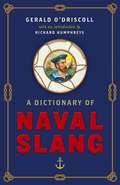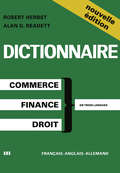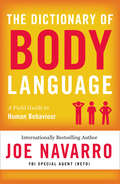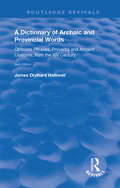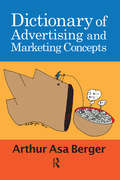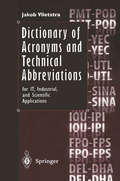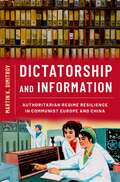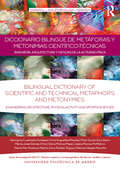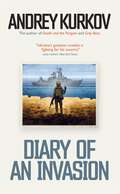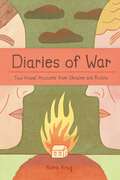- Table View
- List View
A Dictionary of Naval Slang
by Gerald O'DriscollFor centuries the sailors of the Royal Navy have been famous for their colourful language. Trapped aboard leaky ships and creaking vessels for months, sometimes years, on end, the crews developed a peculiar language all of their own. Veteran sailor Gerald O’Driscoll celebrated the Royal Navy's heydey and preserved its unique language in this hilarious and fascinating collection. Taking the reader from 'Acting green' all the way to 'Water-rat', A Dictionary of Naval Slang is a treasury of naval argot, jargon, lingo and cant, and a window on the lost world of living on the high seas. First published in 1943, this modern gift edition comes with a foreword by author and former Royal Navy submariner Richard Humphreys. Clampy - Nickname for the owner of very large feet. Gutzkrieg - A pain in the stomach. Rum- fiend - As the term implies, a man who is a glutton for rum. Scaly-back - A veteran; one who has been too long in the navy. Tin-eye - Nickname given to anyone who sports a monocle. Wall-flower - Scathing reference to any ship which remains moored to a dockyard wall for a long period.
Dictionary of Media and Communication Studies
by James Watson Anne HillThe Dictionary of Media and Communication Studies has provided students and the general public alike with a gateway into the study of intercultural communication, public relations and marketing communications since 1984. In this 9th edition, James Watson and Anne Hill provide a detailed compendium of the different facets of personal, group, mass-media and internet communication that continues to be a vital source of information for all those interested in how communication affects our lives. They cover new applications and developments, such as the incorporation of Neuroscience techniques in advertising and marketing. Other updates include Cyber-bullying, Twitter scandals, conduct in media organizations, on-line lobbying, global protesting/petitioning, and gender issues relating to social media in general. While new entries explore the profound shifts that have taken place in the world of communication in recent years, the purpose of this new edition is not necessarily to keep abreast of every new media event but to reflect the trends that influence and prompt such events, such as the Leveson Inquiry and Report and phone hacking via mobile phones. Politics seems to be playing out more on Twitter than in The Times. This volume seeks to make its twenty-first century readers more media literate, as well as more critical consumers of modern news.
Dictionary of Media and Communication Studies
by James Watson Anne HillThe Dictionary of Media and Communication Studies has provided students and the general public alike with a gateway into the study of intercultural communication, public relations and marketing communications since 1984. In this 9th edition, James Watson and Anne Hill provide a detailed compendium of the different facets of personal, group, mass-media and internet communication that continues to be a vital source of information for all those interested in how communication affects our lives. They cover new applications and developments, such as the incorporation of Neuroscience techniques in advertising and marketing. Other updates include Cyber-bullying, Twitter scandals, conduct in media organizations, on-line lobbying, global protesting/petitioning, and gender issues relating to social media in general. While new entries explore the profound shifts that have taken place in the world of communication in recent years, the purpose of this new edition is not necessarily to keep abreast of every new media event but to reflect the trends that influence and prompt such events, such as the Leveson Inquiry and Report and phone hacking via mobile phones. Politics seems to be playing out more on Twitter than in The Times. This volume seeks to make its twenty-first century readers more media literate, as well as more critical consumers of modern news.
Dictionary of Electronics, Computing and Telecommunications/Wörterbuch der Elektronik, Datentechnik und Telekommunikation: Part 2: English-German/Teil 2: Englisch-Deutsch
by Vittorio FerrettiSince the first edition was published, new technologies have come up, especially in the area of convergence of Computing and Communications, accompanied by a lot of new technical terms. This second expanded and updated edition has been worked out to cope with this situation. The number of entries has been incremented by 35%. With about 159,000 entries, this dictionary offers a valuable guide to navigate through the entanglement of German and English terminology. The lexicographic concept (indication of the subject field for every term, short definitions, references to synonyms, antonyms, general and derivative terms) has been maintained, as well as the tabular layout.
Dictionary of Commercial, Financial and Legal Terms / Dictionnaire des Termes Commerciaux, Financiers et Juridiques / Wörterbuch der Handels-, Finanz- und Rechtssprache: (pdf)
by HerbstThe Dictionary of Body Language: A Field Guide To Human Behavior
by Joe NavarroFrom former FBI agent and bestselling author Joe Navarro, a field guide companion to his classic What Every BODY is Saying, revealing the more than 400 essential body language indicators.
A Dictionary of Archaic and Provincial Words: Obsolete Phrases, Proverbs, and Ancient Customs, from the XIV Century (Routledge Revivals)
by James Orchard HalliwellSo far I may be permitted to speak without intrenching on the limits of criticism. A work containing more than 50,000 words, many of which have never appeared even in scattered glossaries, and illustrated, with very few exceptions, by original authorities, much contain valuable material for the philogist, even if disfigured by errors. With respect to the latter contingency, I am not acquainted with any glossary, comprising merely a few hundred words which does not contain blunders, although in many instances the careful attention of the editor has been specially directed to the task. Can I then anticipate that in a field so vast that no single life would sufice for a minute examination of every object, I could have escaped proportionate liabilities? That such may be pointed out I have little doubt, notwithstanding the pains to prevent their occurrence, but it will be manifestly unfair to make them the test of merit, or thence to pronounce a judgement on the accuracy of the whole.
A Dictionary of Archaic and Provincial Words: Obsolete Phrases, Proverbs, and Ancient Customs, from the XIV Century (Routledge Revivals)
by James Orchard HalliwellSo far I may be permitted to speak without intrenching on the limits of criticism. A work containing more than 50,000 words, many of which have never appeared even in scattered glossaries, and illustrated, with very few exceptions, by original authorities, much contain valuable material for the philogist, even if disfigured by errors. With respect to the latter contingency, I am not acquainted with any glossary, comprising merely a few hundred words which does not contain blunders, although in many instances the careful attention of the editor has been specially directed to the task. Can I then anticipate that in a field so vast that no single life would sufice for a minute examination of every object, I could have escaped proportionate liabilities? That such may be pointed out I have little doubt, notwithstanding the pains to prevent their occurrence, but it will be manifestly unfair to make them the test of merit, or thence to pronounce a judgement on the accuracy of the whole.
Dictionary of Advertising and Marketing Concepts
by Arthur Asa BergerFrom AdBusters to viral marketing, this brief dictionary of ideas and concepts contains over 100 extended, illuminating entries to bring the novice up to speed on the advertising/marketing world and the ideas that underlie it. For the neophyte professional, it describes the various players and strategies of the industry. For the student, it summarizes the key ideas of the most important cultural theorists introduced in advertising and marketing courses. For everyone, it helps explain the cultural, economic, and psychological role that advertising concepts play in society. A handy introduction for students and a quick reference for young professionals.
Dictionary of Advertising and Marketing Concepts
by Arthur Asa BergerFrom AdBusters to viral marketing, this brief dictionary of ideas and concepts contains over 100 extended, illuminating entries to bring the novice up to speed on the advertising/marketing world and the ideas that underlie it. For the neophyte professional, it describes the various players and strategies of the industry. For the student, it summarizes the key ideas of the most important cultural theorists introduced in advertising and marketing courses. For everyone, it helps explain the cultural, economic, and psychological role that advertising concepts play in society. A handy introduction for students and a quick reference for young professionals.
Dictionary of Acronyms and Technical Abbreviations: For Information and Communication Technologies and Related Areas
by Jakob VlietstraThis Dictionary covers information and communication technology (ICT), including hardware and software; information networks, including the Internet and the World Wide Web; automatic control; and ICT-related computer-aided fields. The Dictionary also lists abbreviated names of relevant organizations, conferences, symposia and workshops. This reference is important for all practitioners and users in the areas mentioned above, and those who consult or write technical material. This Second Edition contains 10,000 new entries, for a total of 33,000.
Dictionary of Acronyms and Technical Abbreviations: for IT, Industrial, and Scientific Applications
by Jakob VlietstraMy first encoWlter with acronyms took place when I was ten years old and growing up in an occupied COWltry during the Second World War. My father proudly annoWlced one day that, despite the ban imposed by the occupying administration, he had managed to get a radio installed and could receive the BBC. (All acronyms used in this introduction are listed in this dictionary.) To me the meaning of"BBC" was that we would receive different information about the war than we got from the usual censored broadcasts. There was, of course, the well-known acronym associated with the nT, but at that time I did not realize that it meant more than the postal service, in those years a deteriorated service. Gradually the daily use of acronyms grew. Most of the newly acquired three-and four-letter abbreviations referred to organiza tions, such as the broadcasting corporations in The Netherlands and Belgium, and references to coWltries such as the USA, USSR, and UK. When attending high school (the HBS) after the war, my knowledge of acronyms grew slowly. Even during the ten years I spent in the Dutch Merchant Marine (the GHV), the number of acronyms was limited to ad vanced equipment that eventually became known as RADAR, LORAN, and DECCA.
Dictatorship and Information: Authoritarian Regime Resilience in Communist Europe and China
by Martin K. DimitrovFear pervades dictatorial regimes. Citizens fear leaders, the regime's agents fear superiors, and leaders fear the masses. The ubiquity of fear in such regimes gives rise to the "dictator's dilemma," where autocrats do not know the level of opposition they face and cannot effectively neutralize domestic threats to their rule. The dilemma has led scholars to believe that autocracies are likely to be short-lived. Yet, some autocracies have found ways to mitigate the dictator's dilemma. As Martin K. Dimitrov shows in Dictatorship and Information, substantial variability exists in the survival of nondemocratic regimes, with single-party polities having the longest average duration. Offering a systematic theory of the institutional solutions to the dictator's dilemma, Dimitrov argues that single-party autocracies have fostered channels that allow for the confidential vertical transmission of information, while also solving the problems associated with distorted information. To explain how this all works, Dimitrov focuses on communist regimes, which have the longest average lifespan among single-party autocracies and have developed the most sophisticated information-gathering institutions. Communist regimes face a variety of threats, but the main one is the masses. Dimitrov therefore examines the origins, evolution, and internal logic of the information-collection ecosystem established by communist states to monitor popular dissent. Drawing from a rich base of evidence across multiple communist regimes and nearly 100 interviews, Dimitrov reshapes our understanding of how autocrats learn--or fail to learn--about the societies they rule, and how they maintain--or lose--power.
Dictatorship and Information: Authoritarian Regime Resilience in Communist Europe and China
by Martin K. DimitrovFear pervades dictatorial regimes. Citizens fear leaders, the regime's agents fear superiors, and leaders fear the masses. The ubiquity of fear in such regimes gives rise to the "dictator's dilemma," where autocrats do not know the level of opposition they face and cannot effectively neutralize domestic threats to their rule. The dilemma has led scholars to believe that autocracies are likely to be short-lived. Yet, some autocracies have found ways to mitigate the dictator's dilemma. As Martin K. Dimitrov shows in Dictatorship and Information, substantial variability exists in the survival of nondemocratic regimes, with single-party polities having the longest average duration. Offering a systematic theory of the institutional solutions to the dictator's dilemma, Dimitrov argues that single-party autocracies have fostered channels that allow for the confidential vertical transmission of information, while also solving the problems associated with distorted information. To explain how this all works, Dimitrov focuses on communist regimes, which have the longest average lifespan among single-party autocracies and have developed the most sophisticated information-gathering institutions. Communist regimes face a variety of threats, but the main one is the masses. Dimitrov therefore examines the origins, evolution, and internal logic of the information-collection ecosystem established by communist states to monitor popular dissent. Drawing from a rich base of evidence across multiple communist regimes and nearly 100 interviews, Dimitrov reshapes our understanding of how autocrats learn--or fail to learn--about the societies they rule, and how they maintain--or lose--power.
Dickens, Reynolds, and Mayhew on Wellington Street: The Print Culture of a Victorian Street (The Nineteenth Century Series)
by Mary L. ShannonA glance over the back pages of mid-nineteenth-century newspapers and periodicals published in London reveals that Wellington Street stands out among imprint addresses. Between 1843 and 1853, Household Words, Reynolds’s Weekly Newspaper, the Examiner, Punch, the Athenaeum, the Spectator, the Morning Post, and the serial edition of London Labour and the London Poor, to name a few, were all published from this short street off the Strand. Mary L. Shannon identifies, for the first time, the close proximity of the offices of Charles Dickens, G.W.M. Reynolds, and Henry Mayhew, examining the ramifications for the individual authors and for nineteenth-century publishing. What are the implications of Charles Dickens, his arch-competitor the radical publisher G.W.M. Reynolds, and Henry Mayhew being such close neighbours? Given that London was capital of more than Britain alone, what connections does Wellington Street reveal between London print networks and the print culture and networks of the wider empire? How might the editors’ experiences make us rethink the ways in which they and others addressed their anonymous readers as ’friends’, as if they were part of their immediate social network? As Shannon shows, readers in the London of the 1840s and '50s, despite advances in literacy, print technology, and communications, were not simply an ’imagined community’ of individuals who read in silent privacy, but active members of an imagined network that punctured the anonymity of the teeming city and even the empire.
Dickens, Reynolds, and Mayhew on Wellington Street: The Print Culture of a Victorian Street (The Nineteenth Century Series)
by Mary L. ShannonA glance over the back pages of mid-nineteenth-century newspapers and periodicals published in London reveals that Wellington Street stands out among imprint addresses. Between 1843 and 1853, Household Words, Reynolds’s Weekly Newspaper, the Examiner, Punch, the Athenaeum, the Spectator, the Morning Post, and the serial edition of London Labour and the London Poor, to name a few, were all published from this short street off the Strand. Mary L. Shannon identifies, for the first time, the close proximity of the offices of Charles Dickens, G.W.M. Reynolds, and Henry Mayhew, examining the ramifications for the individual authors and for nineteenth-century publishing. What are the implications of Charles Dickens, his arch-competitor the radical publisher G.W.M. Reynolds, and Henry Mayhew being such close neighbours? Given that London was capital of more than Britain alone, what connections does Wellington Street reveal between London print networks and the print culture and networks of the wider empire? How might the editors’ experiences make us rethink the ways in which they and others addressed their anonymous readers as ’friends’, as if they were part of their immediate social network? As Shannon shows, readers in the London of the 1840s and '50s, despite advances in literacy, print technology, and communications, were not simply an ’imagined community’ of individuals who read in silent privacy, but active members of an imagined network that punctured the anonymity of the teeming city and even the empire.
Diccionario Bilingüe de Metáforas y Metonimias Científico-Técnicas: Ingeniería, Arquitectura y Ciencias de la Actividad Física
by Georgina Cuadrado EsclapezDiccionario Bilingüe de Metáforas y Metonimias Científico-Técnicas presents the extensive range of metaphoric and metonymic terms and expressions that are commonly used within the fields of science, engineering, architecture and sports science. Compiled by a team of linguists working across a range of technical schools within the Universidad Politécnica de Madrid, this practical dictionary fills a gap in the field of technical language and will be an indispensable reference for students within the fields of science, engineering or sports science seeking to work internationally and for translators and interpreters working in these specialist fields.
Diccionario Bilingüe de Metáforas y Metonimias Científico-Técnicas: Ingeniería, Arquitectura y Ciencias de la Actividad Física
by Georgina Cuadrado EsclapezDiccionario Bilingüe de Metáforas y Metonimias Científico-Técnicas presents the extensive range of metaphoric and metonymic terms and expressions that are commonly used within the fields of science, engineering, architecture and sports science. Compiled by a team of linguists working across a range of technical schools within the Universidad Politécnica de Madrid, this practical dictionary fills a gap in the field of technical language and will be an indispensable reference for students within the fields of science, engineering or sports science seeking to work internationally and for translators and interpreters working in these specialist fields.
Diary of an Invasion: The Russian Invasion Of Ukraine
by Andrey Kurkov'Uplifting and utterly defiant' Matt Nixson, Daily Express 'Immediate and important ... This is an insider's account of how an ordinary life became extraordinary' Helen Davies, The TimesThis journal of the invasion, a collection of Andrey Kurkov's writings and broadcasts from Kyiv, is a remarkable record of a brilliant writer at the forefront of a 21st-century war. Andrey Kurkov has been a consistent satirical commentator on his adopted country of Ukraine. His most recent work, Grey Bees, is a dark foreshadowing of the devastation in the eastern part of Ukraine in which only two villagers remain in a village bombed to smithereens. The author has lived in Kyiv and in the remote countryside of Ukraine throughout the Russian invasion. He has also been able to fly to European capitals where he has been working to raise money for charities and to address crowded halls. Kurkov has been asked to write for every English newspaper, as also to be interviewed all over Europe. He has become an important voice for his people.Kurkov sees every video and every posted message, and he spends the sleepless nights of continuous bombardment of his city delivering the truth about this invasion to the world.
Diary Methods: Understanding Qualitative Research (Understanding Qualitative Research)
by Lauri L. HyersQualitative diary research is a unique tool with strengths that set it apart from other research methods. The diary prioritizes events embedded in context and time, a perspective that serves to destabilize constants, revealing the complex intersectionality of experience. Over the last several centuries, the mechanics of diary-keeping have evolved from simple records of ephemera into a primary research method. Today both archival and solicited diaries are used by social scientists who employ a range of qualitative, quantitative, and mixed-method data collection technologies. Researchers may consider the very possibility of conducting a qualitative diary study with some hesitation--in addition to sounding like a good deal of work, the method seems somewhat off the beaten path, a bit mysterious, and even kitschy. With a better understanding of what is involved, those who are considering the method may come to find that a diary study is well worth their while. In Diary Methods, Hyers provides her readers with a wealth of guidance and expert insight to ensure the success of their qualitative diary studies. The history of the diary from cultural phenomenon to social scientific method are explored, followed by a discussion of the use of archival and solicited diaries in qualitative designs, diary data collection and management, qualitative analysis and coding, composition and diary report writing, evaluating diary research, and special ethical considerations when using diaries in research.
Diary Methods: Understanding Qualitative Research (Understanding Qualitative Research)
by Lauri L. HyersQualitative diary research is a unique tool with strengths that set it apart from other research methods. The diary prioritizes events embedded in context and time, a perspective that serves to destabilize constants, revealing the complex intersectionality of experience. Over the last several centuries, the mechanics of diary-keeping have evolved from simple records of ephemera into a primary research method. Today both archival and solicited diaries are used by social scientists who employ a range of qualitative, quantitative, and mixed-method data collection technologies. Researchers may consider the very possibility of conducting a qualitative diary study with some hesitation--in addition to sounding like a good deal of work, the method seems somewhat off the beaten path, a bit mysterious, and even kitschy. With a better understanding of what is involved, those who are considering the method may come to find that a diary study is well worth their while. In Diary Methods, Hyers provides her readers with a wealth of guidance and expert insight to ensure the success of their qualitative diary studies. The history of the diary from cultural phenomenon to social scientific method are explored, followed by a discussion of the use of archival and solicited diaries in qualitative designs, diary data collection and management, qualitative analysis and coding, composition and diary report writing, evaluating diary research, and special ethical considerations when using diaries in research.
Diaries of War: Two Visual Accounts from Ukraine and Russia
by Nora KrugAn account of two lives during the war in Ukraine: one Ukrainian, one Russian, by the internationally bestselling author of Heimat Diaries of War is a magnificent feat of witness' Alison Bechdel 'Nora Krug's narrative can emotionally drain the reader, but the reader is unlikely to ever forget this book' Andrey Kurkov Immediately following Russia's invasion of Ukraine in February 2022, Nora Krug connected with two anonymous subjects - 'K.', a Ukrainian journalist, and 'D.', a Russian artist - and began what would become a year of correspondence. Deeply moved by the rawness of their responses, she felt that through the personal accounts of these individuals who, directly and indirectly, experienced the war firsthand, she might be able to communicate something of the war and its human impact. Over the course of the next twelve months she communicated with each of them individually via phone chat, condensing their sometimes fluid, sometimes fragmentary answers into a consistent narrative and then created illustrations to go with each entry. The personal accounts contained in this book chronicle the first year of Russia's invasion of Ukraine in an intimate, epistolary format.Diaries of War explores the personal, the political, conflict, family and daily life under war with immense skill, compassion and moving thoughtfulness. Through these two individuals we see the granular effects of war on two lives, but they are emblematic of millions. Diaries of War is a harrowing record of a heart-wrenching historical event that has devastated the world and continues to alter countless lives.
The Diaries of Anthony Hewitson, Provincial Journalist, Volume 1: 1865–1887
by Andrew HobbsAnthony Hewitson (1836-1912) was a typical Victorian journalist, working in one of the largest sectors of the periodical press, provincial newspapers. His diaries, written between 1862 and 1912, lift the veil of anonymity hiding the people, processes and networks involved in the creation of Victorian newspapers. They also tell us about Victorian fatherhood, family life, and the culture of a Victorian town. Diaries of nineteenth-century provincial journalists are extremely rare. Anthony Hewitson went from printer’s apprentice to newspaper reporter and eventually editor of his own paper. Every night he jotted down the day’s doings, his thoughts and feelings. The diaries are a lively account of the reporter’s daily round, covering meetings and court cases, hunting for gossip or attending public executions and variety shows, in and around Preston, Lancashire. Andrew Hobbs’s introduction and footnotes provide background and analysis of these valuable documents. This full scholarly edition offers a wealth of new information about reporting, freelancing, sub-editing, newspaper ownership and publishing, and illuminates aspects of Victorian periodicals and culture extending far beyond provincial newspapers. The Diaries of Anthony Hewitson, Provincial Journalist are an indispensable research tool for local and regional historians, as well as social and political historians with an interest in Victorian studies and the media. They are also illuminating for anyone interested in nineteenth-century social and cultural history. Open Book Publishers gratefully acknowledge funding for this book from the Marc Fitch Fund, the Historic Society of Lancashire & Cheshire, and the University of Central Lancashire.
A DIAMOND IN THE DESERT: Behind the Scenes in the World's Richest City
by Jo TatchellBarely forty years ago, Abu Dhabi was a fishing village on the Arabian Gulf. Now the capital of the United Arab Emirates, its citizens are each worth $17 million, it holds major stakes in Western economies, and has money to burn. In this timely, revealing and evocative portrait of a global player, Jo Tatchell traces the emirate's dramatic development and the sometimes ruinous effect of extreme wealth on its people and their desert culture. And as its rulers fund another giant leap forward, she probes behind the official facade to examine whether this secretive and controlled society can realise its breathtaking plans to transform relations between East and West.
Dialogues on the Theory and Practice of Literary Translation (China Perspectives)
by Xu JunThe book is a collection of the dialogues between Xu Jun, a well-known expert in French literary translation and eminent “Changjiang” scholar in translation studies in China, and some celebrated literary translators in contemporary China, some of whom are also literary scholars, linguists, poets, prose writers, and editors. It is a fundamental achievement of research on the literary translation in the 20th century in China, involving multiple literary types, such as novels, poetry, dramas, prose, and fairy tales; and multiple languages, such as English, French, German, Russian, Italian, Spanish, Japanese, and Sanskrit. The dialogues are centered on fundamental issues in the theory and practice of literary translation, such as re-creation in literary translation, the relationship between form and content in literary translation, the subjectivity of literary translators, literary translation standards and principles, the gains and losses in literary translation, the principles and methods of literary criticism, and so on. Those translation experts’ experience and multiple strategies not only play an active role in guiding literary translators in practice but also benefit theoretical development in literary translation. Thus, the book will contribute to worldwide translation studies and get well recognized by translation studies students, teachers, and scholars in the world.
